Home · Book Reports · 2018 · Change Your Posture, Change Your Life

- Author :: Richard Brennan
- Publication Year :: 2012
- Read Date :: 2018-04-03
- Source :: Change_Your_Posture, Change_Your_Life.epub
designates my notes. / designates important.
Thoughts
There really isn’t much here, in 173 pages. The most obvious statement, which might not be very common today, is to be conscious about how you hold and carry your body.
Using mirrors of having others offer you feedback about how you are actually positioned may reveal that how you think you are standing/sitting is not how you actually are standing/sitting. It seems like common sense that empirical data should be held up in favor of what you think.
Lastly I would agree with the idea that: if something is hurting, why is it? Another common sense question in my mind, but many may not think to look for a root cause. Particularly in our world where surgical operations and lifetime prescriptions are seen as the only path to health.
Before going to such extremes to relieve or mask pain, ask: what are you doing and how are you doing it? Is there a better way?
The book itself promotes what I’ll call a hippy dippy view. The author promotes Ram Das and his destructive live in the moment attitude alongside none other than Aldous Huxley. I wouldn’t say the author even realizes the extent that these two are bad actors, but it should be mentioned seeing as how someone duped by these two agents might not be the best place to go for advice, in any arena.
I also wonder, how did this guy (this author, not Alexander) write four books about this topic? This one goes on and on, stories taking up the lion’s share of the book. The technique could be introduced, and even extolled, in two dozen pages, plus pictures. The stories add little but human interest, good if you are looking for a pick me up or as part of a sales pitch, not so good if you want to get down to brass tacks.
Again it is the hippy philosophy that turns me off more than anything else. The technique itself seems more than reasonable.
A year or more before I read this book, I followed a similar path of thinking when I built a custom ergonomic ‘desk’.
Books
-
“The rise in back problems over the last century correlates directly with the increasing number of hours we spend seated.” -Professor Galen Cranz, author of The Chair
-
Books by F M Alexander:
The Use of the Self, Gollancz, 1985
The Universal Constant in Living, Centerline Press, 1986
Man’s Supreme Inheritance, Centerline Press, 1988
Constructive Conscious Control of the Individual, Gollancz, 1987
Exceptional Excerpts
“Interference with the physiological mechanisms often occurs habitually and unconsciously.”)
“The way in which a person uses themselves will invariably affect their various functions.”)
Table of Contents
- Introduction
- 01: Alexander Technique – the Benefits
- 02: The Origin of the Technique
- 03: The Development of the Technique
- 04: How the Alexander Technique Works
- 05: Understanding Posture
- 06: Posture and Education
- 07: The Secret Key to Good Posture
- 08: The Effects of Furniture on Posture
- 09: The Hidden Obstacle to Improving Posture
- 10: Your Inner Acrobat
- 11: Inside Yourself
- 12: Posture and Shoes
- 13: First Steps To Improving Posture
- 14: Posture and Breathing
- 15: Bringing Your Life Back Into Balance
- Glossary
- Pdf page numbers.
· Introduction
page 8:
-
your posture directly affects your body’s overall functioning and has a major influence on how you think and feel. Poor posture can also adversely affect the position and functioning of your vital organs and cause more health problems than you realize. Many people with chronic pain can trace their problems to years of faulty postural habits. Good posture, by contrast, promotes free movement and physical and mental endurance, improves appearance
-
Improving posture reduces fatigue, muscular strain and pain.
· 01: Alexander Technique – the Benefits
page 12:
-
In many cases pain is simply the body’s alarm system, it is just saying ‘Stop doing this to me’
-
Marjorie Barlow, Alexander’s niece
-
John Perry relation?
page 23:
- Mark Twain, ‘If you do what you always did, you will get what you always got.’
page 24:
- There are many inspiring books about the benefits of living in the present,
· 02: The Origin of the Technique
page 28:
-
How many people do you know with back or neck problems who have ever had the thought that they may be causing the problem themselves?
-
At least one. :)
page 29:
- Alexander’s first discovery was: Interference with the physiological mechanisms often occurs habitually and unconsciously.
page 30:
-
Alexander’s second discovery was: The existence of the Primary Control, which organizes balance and coordination throughout the rest of the body.
-
Alexander referred to the dynamic relationship between the head, neck and back as the ‘Primary Control’ and discovered that it governed the workings of all the body’s mechanisms and made the control of the complex human being relatively simple.
-
Alexander’s third discovery was: The way in which a person uses themselves will invariably affect their various functions.
-
The existence of faulty sensory appreciation
page 31:
- The body does not function as a collection of separate independent parts, but as a whole unit, with every part affecting every other part.
- A given stimulus produces the same reaction over and over again, which, if it goes unchecked, turns into habitual behaviour. This habitual reaction will eventually feel normal and natural to us.
page 33:
- Summary of Alexander’s discoveries:
1. Interference with our physiological mechanisms (poor posture) often occurs
habitually and unconsciously.
2. The existence Primary Control, which organizes balance and coordination
throughout the rest of oneself.
3. The way in which we use ourselves will invariably affect all of our various
functions.
4. The existence of faulty sensory appreciation.
5. The body does not function as a collection of separate independent parts but
as a whole unit with every part affecting every other part.
6. A given stimulus produces the same reaction over and over again, which, if
it goes unchecked, turns into habitual behaviour. This habitual reaction will
feel normal and natural to us.
7. Directing – to change a habit that involves muscular tension, we need to
just think of what we want the muscle to do rather than actually changing it by
using even more tension.
8. Inhibiting – to refuse to react to any stimulus in our automatic habitual
way.
9. Eliminating ‘end-gaining’ – by inhibiting and directing, we can pay
attention to how we perform an action and not be only thinking about the end
result.
10. The mind, body and emotions are not separate entities, but act in unity
with each other.
· 03: The Development of the Technique
page 37:
- In 1917 Alexander met the well-known American philosopher and educationist, John Dewey, while visiting America. Dewey was a prominent voice of the school of philosophy known as pragmatism and had an enormous influence on American education – in fact, he is sometimes known as ‘the father of American education’. Dewey continued taking Alexander Technique lessons for the next 35 years and was so taken by the Technique that he wrote the introductions to three of Alexander’s books.
page 38:
- Alexander also helped the famous author Aldous Huxley, when his poor physical state threatened to end his writing career. Huxley came to see Alexander after he had been suffering from chronic fatigue, insomnia and a weak stomach. He was virtually bedridden and had been reduced to writing lying down with his typewriter resting on his chest. Learning and applying the principles of the Alexander Technique enabled him to resume his normal activities and live a good healthy life for another quarter-century.
page 39:
- he even based a character (‘Miller’) in his 1936 novel Eyeless in Gaza on Alexander. Huxley firmly believed that the Alexander Technique was a ‘totally new type of education, affecting the entire range of human activity, from a physiological through the intellectual, moral, and practical to the spiritual’ and was not afraid to publicize the fact.
· 04: How the Alexander Technique Works
page 42:
- The Alexander Technique also involves examining and improving posture, breathing, balance and coordination, which are inseparable from one another.
page 43:
- It is often hard for us to detect this increase in tension because it builds up gradually over the years. We become accustomed to the ways in which we sit and stand, and while these ways may feel comfortable to us, they are often putting strain upon our body without our realizing it. No matter how uncoordinated these positions become, they will feel right to us. In the end, poor posture, or as Alexander called it, ‘misuse’, will feel comfortable and ‘right’ and good posture (similar to the original natural posture we had as a young child) will initially feel strange and wrong. This is the effect of what Alexander termed ‘faulty sensory appreciation’.
page 46:
- Contemporary methods of combating such problems typically involve powerful painkilling or anti-inflammatory drugs, or muscle relaxants, but these can block out the body’s warning system, whose function it is to tell us that something is wrong. Often, doctors can offer little advice because their training centres on treating symptoms rather than uncovering, and rectifying, the actual causes of such problems.
page 47:
-
The Alexander Technique, however, does the opposite. It can show you the underlying causes, so that you are then able to eliminate the tension responsible for many of the ailments that are so often mistakenly put down to the ageing process.
-
One of the most common examples of how posture can affect our health is back pain. According to the UK-based charity BackCare, on average a third of people living in industrialized countries suffer from back pain at any given time, and a staggering 80 per cent of the population of these countries will have disabling back pain at some point in their lives. The Health and Safety Executive in the UK agrees that back pain will affect as many as four-fifths of people during their lifetime and results in 4.5 million working days lost each year. In the US, the National Center for Health Statistics reports very similar percentages. They say that over 76 million people in the US are suffering with backache at any given moment.
-
Statistics reveal that back pain is on the increase in most industrialized countries, yet there are no clear solutions to the problem in the established medical sciences.
-
Although large sums of money are being spent on treatment of the pain
page 48:
-
I came to the Technique through back pain. This was primarily caused by poor posture due to my sedentary profession as a driving instructor.
-
I often spent over 50 hours a week sitting in a car, and after several years at the job I developed lower back pain. At first it was an occasional aching back that was relieved by massage or some gentle exercise, but before long I was suffering with such a very painful condition that I could hardly walk.
page 49:
- At this stage I started to investigate various forms of alternative medicine. These included the more established therapies, such as chiropractic, osteopathy, homeopathy and acupuncture, and then I tried less orthodox treatments, such as reflexology, metamorphic technique, aromatherapy, Reiki and spiritual healing.
page 50:
- If you were driving a car and the oil light came on, you would not take out the bulb and carry on driving; this, of course, would be foolish. You would stop the car and endeavour to find what was wrong, and if you did not you could expect more serious problems later. Yet we are not encouraged to apply the same logic to the body.
page 51:
- Learning the Alexander Technique consists of four stages:
1. Becoming aware of all postural habits that cause or exacerbate a lack of
coordination and a general misuse of yourself.
2. Releasing the unwanted tension accumulated over many years of standing,
moving or sitting in an uncoordinated manner.
3. Learning new ways of moving, standing or sitting that are easier and more
efficient and that put less stress on the body, thus reducing excessive wear
and tear on the bones and joints as well as allowing all the internal organs
space to function naturally.
4. Learning new ways of reacting physically, emotionally and mentally to
various situations.
page 53:
- The freedom of the neck is of primary importance, for without it the head cannot balance freely on top of the spine, which is essential for good posture One of the first things an Alexander teacher usually shows you is how to release the tension in the neck.
page 54:
-
The key to learning the Technique is awareness. It may seem a little odd at first to make an effort to become aware of how we perform various tasks, because many of our movements have become automatic and we tend to perform them over and over again in the same way without conscious thought. Gradually, though, we learn to think briefly before performing any given action to see if it can be carried out with much less tension.
-
you will not be learning anything new, but simply unlearning the bad habits you have acquired during the course of your life. Alexander often said that if you stopped doing the wrong thing (i.e. the habit), the right thing would happen by itself,
page 55:
- it is often easier for others to see these [habits, patterns, postures] when we ourselves cannot.
· 05: Understanding Posture
page 62:
-
A more accurate definition of the word posture is: The relationship of one or more parts of the body to the rest.
-
Postural muscles hold you up, phasic muscles move you.
- The crucial point here is that trying to improve posture by deliberately sitting up straight and pulling our shoulders back will never ever work, no matter how hard we try, because we will be using our phasic muscles rather than our postural muscles to do so.
· 06: Posture and Education
page 69:
- In his book Body Awareness in Action, Professor Frank Pierce Jones states that two of the most powerful stimuli for producing malposture are a book and a pencil, and it is easy to see that children’s posture starts to change within a few years of beginning school. Poor posture in teenagers is now widespread in developed countries, and we are beginning to see it as normal…
page 72:
- Alexander was also a firm believer that our education system did not address the real needs of our children, and as a result in 1924 he and his assistants opened a school for children in London. Irene Tasker, a teacher trained by Maria Montessori and also an Alexander teacher, ran what came to be known as ‘The Little School’, which incorporated teaching children the principles of the Alexander Technique as part of the curriculum.
· 07: The Secret Key to Good Posture
page 80:
-
Ram Dass (aka Dr Richard Alpert), an American spiritual teacher who spent a great deal of time in India, often said that one of the most important things people in the West need to learn is that ‘life is not an emergency’. Another thought-provoking saying is: ‘Man says: “Quickly, quickly, hurry up. Time is passing away”, but Time says: “It is not me that passes away, it is man!”
-
Lots of change agents in the book, though I have a feeling the author is a true believer rather than an agent himself.
page 81:
- Quote by Aldous Huxley, but I don’t actually know what it was; poorly formatted.
page 82:
- interesting saying in The Talmud that says, ‘Whoever forces time is pushed back by time; whoever yields to time finds time on his side.’
page 84:
-
The Alexander Technique is a practical way of helping to keep our consciousness in the here and now.
-
Live in the present, but keep one eye on the past and the other eye on the future. Proverb.
· 08: The Effects of Furniture on Posture
page 86:
- “The rise in back problems over the last century correlates directly with the increasing number of hours we spend seated.” -Professor Galen Cranz, author of The Chair
page 87:
-
Since the teacher’s main responsibility is for the safety of all these children, he or she will usually insist that they remain in their chairs for most of the day.
-
Shouldn’t it be to educate them? I mean, how dangerous is a typical classroom?
page 93:
- National Back Pain Association UK, published in October 2005, which stated: “Sustained poor posture, which is probably the key environmental cause of back pain in children and adolescents, results from a combination of factors, the most significant of these seems to be the inappropriate furniture at school.”
page 94:
- To solve the problem, all you need to do is alter the base of the chair so it is no longer sloping backwards. This can easily be achieved by using a wedge-shaped cushion. You can also achieve the same effect by taking two books, about 5cm (2in) thick (old telephone books are ideal), and placing one under each of the back legs of the chair.
page 95:
- It is important to use the wedge-shaped cushion for only one hour on the first day and then gradually build up the amount of time you spend sitting on it. This allows time for your muscles to get used to a new and improved way of sitting. After about three to four weeks, you will be able to sit on the cushion comfortably for as long as you like.
· 09: The Hidden Obstacle to Improving Posture
page 111:
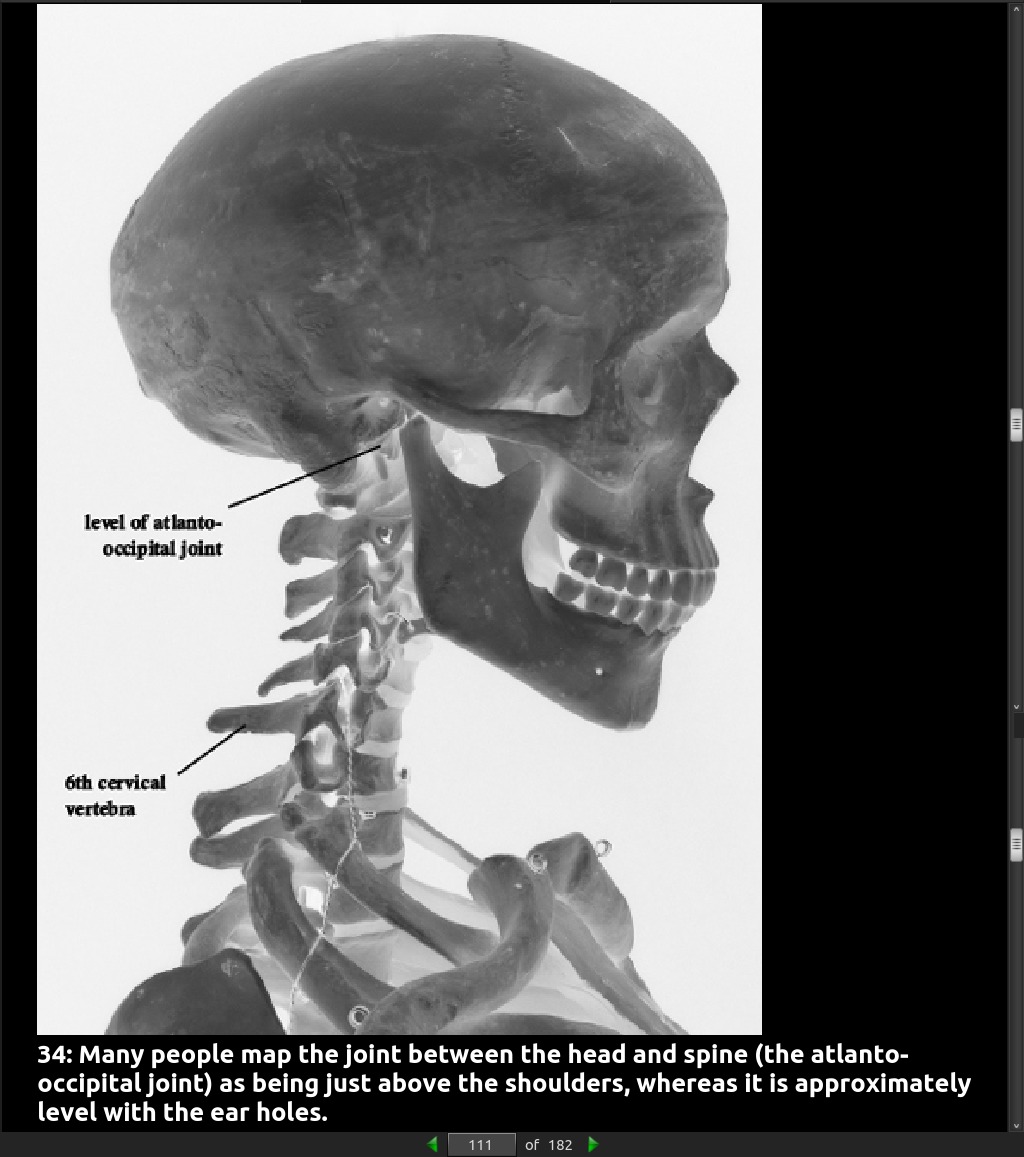
page 112:
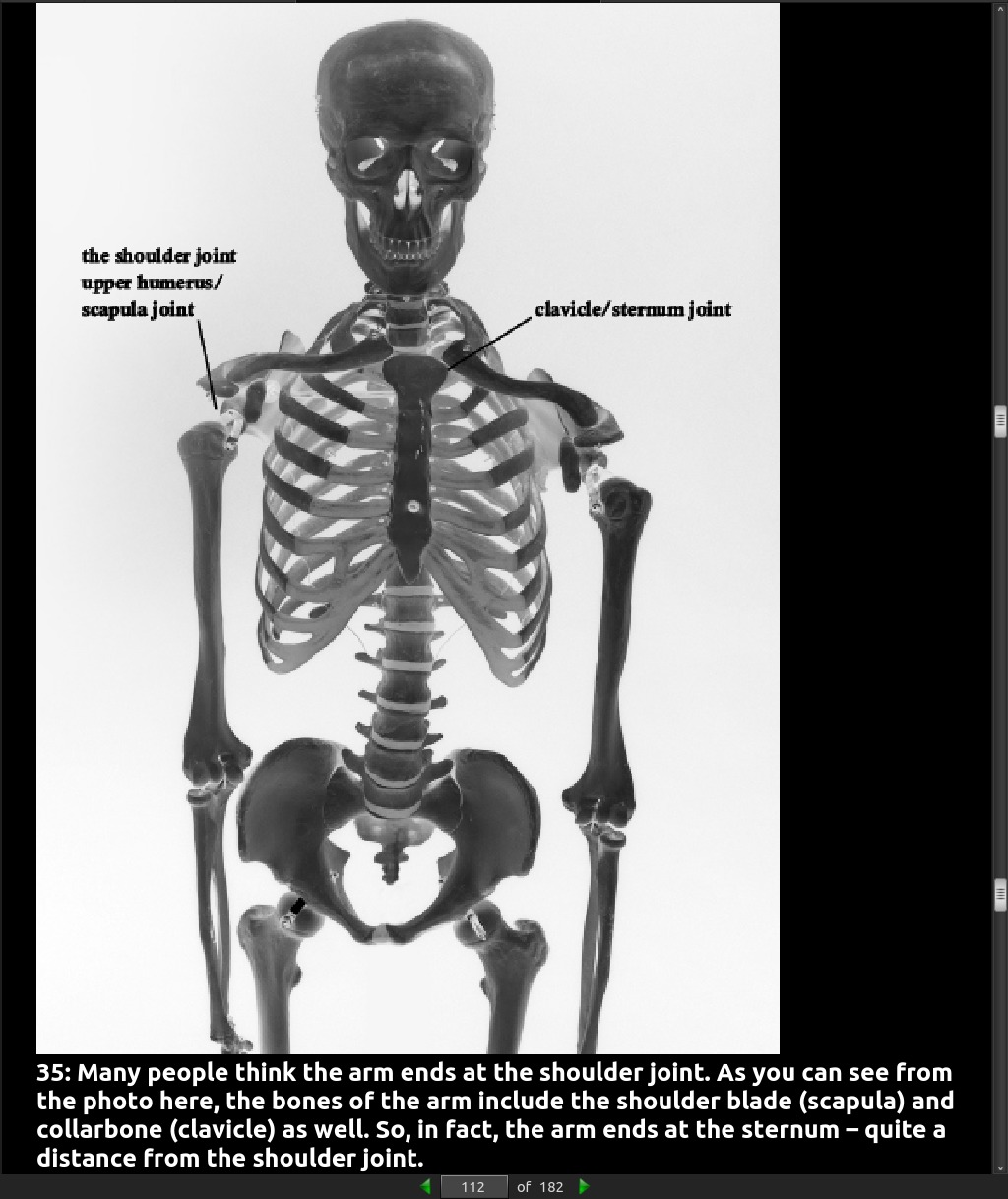
page 114:
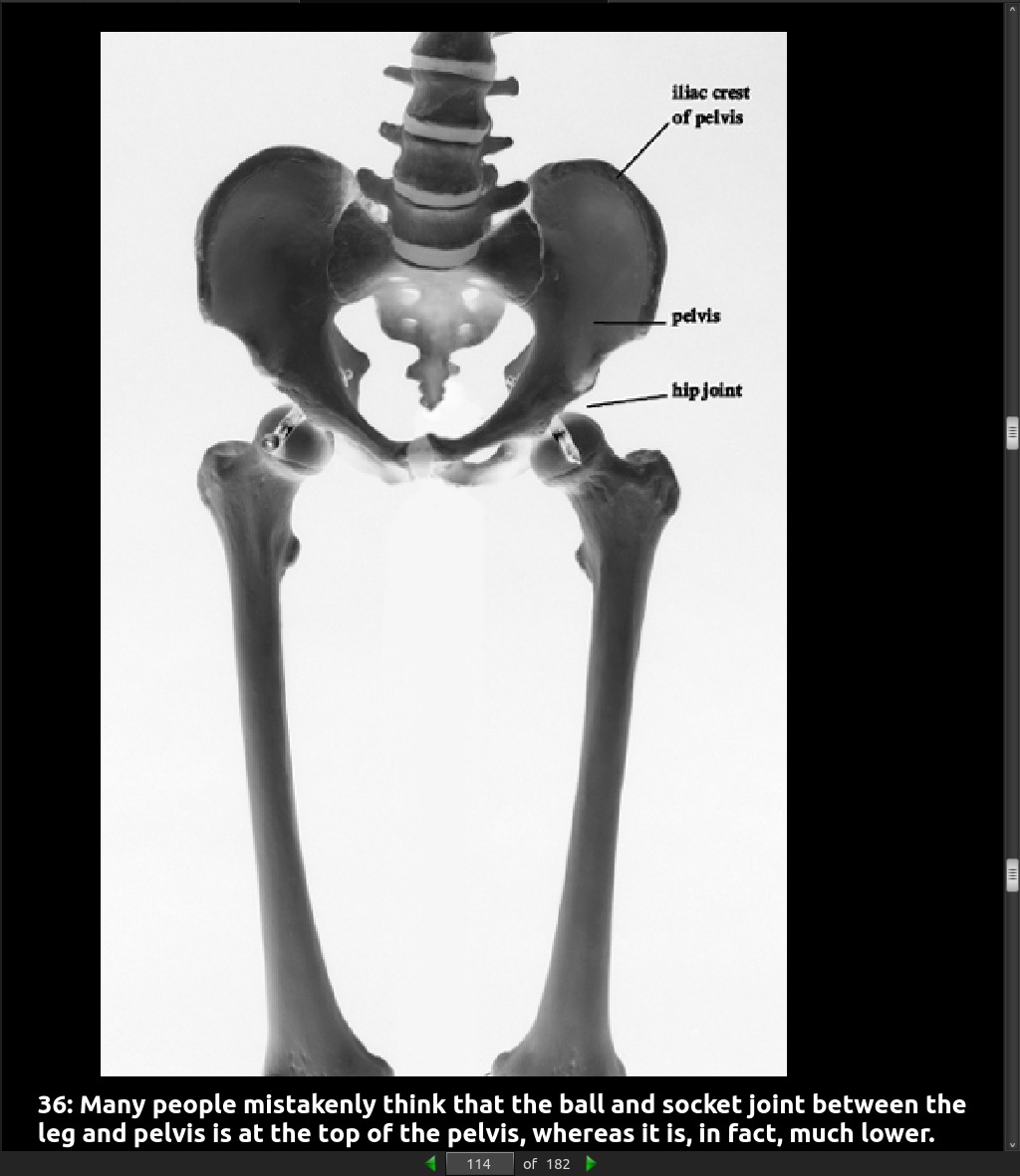
· 10: Your Inner Acrobat
page 117:
- Good posture is synonymous with good balance.
page 118:
- We consist of over 650 muscles and 206 bones
page 120:
- For example, a car or aeroplane needs most power when it accelerates from a stationary position; it needs much less energy to keep it going at a constant speed. The human body, on the other hand, needs no effort to move and actually requires a release of muscle tension. Once the head begins to move forwards, the body will naturally follow,
page 122:
- When standing, the weight distribution should be on three points of each foot, and this brings a certain amount of balance. The first point is the heel, the second is the ball of the foot and the third is situated on the outside of the foot at the beginning of the little toe.
page 123:
-
(1). Place the feet approximately 30cm (12in) apart, as this immediately gives a more stable base on which to support the rest of the body. Note: this measurement is from the inside of the feet; so for tall people the feet need to be a little further apart and for short people a little closer together.
-
(2). When standing for long periods, it is helpful to take one foot approximately 15cm (6in) back, so that about 60 per cent of the weight of the body is resting on the rear foot. Place the feet with an angle of approximately 45 degrees between them. This helps to prevent the all-too-common habit of sinking down into one hip, which can affect the balance and coordination of the whole structure of your body.
-
(3). If you notice that you are pushing your pelvis forward, imagine it gently releasing back without deliberately throwing the body too far forward (make sure you are allowing your neck to be free and your head to move forward and up and your spine to lengthen at the same time). This helps to eliminate the very common tendency of over-arching the back when in a standing position. Note: make sure you are only thinking and not actually doing this action.
-
While you are sitting for relaxation, for example, when using a reclining chair or a sofa or armchair while watching TV, you only need to let the chair fully support you, so that no one part of your body has to bear undue pressure or tension. You can always use cushions to support your head if you need to.
-
My desk @link, seems to be a combination. It supports the entire body while still allowing use of the computer. It does NOT lend itself to writing on paper or reading from physical books.
-
Sitting while in activity is a different matter altogether, and sitting at a desk or table while working or eating requires us to be balanced on the two sitting bones and feet. Make sure that you have even support on all these four areas, and when you are leaning forward at a desk or table, do not bend your spine, but rather use your hip joints and sitting bones to help you to transfer weight from the sitting bones onto the feet. When moving back away from the desk, just reverse the process and transfer your weight back over your sitting bones. While you are sitting during any activity, try to be balanced, poised and movable rather than hold any one fixed position.
page 127:
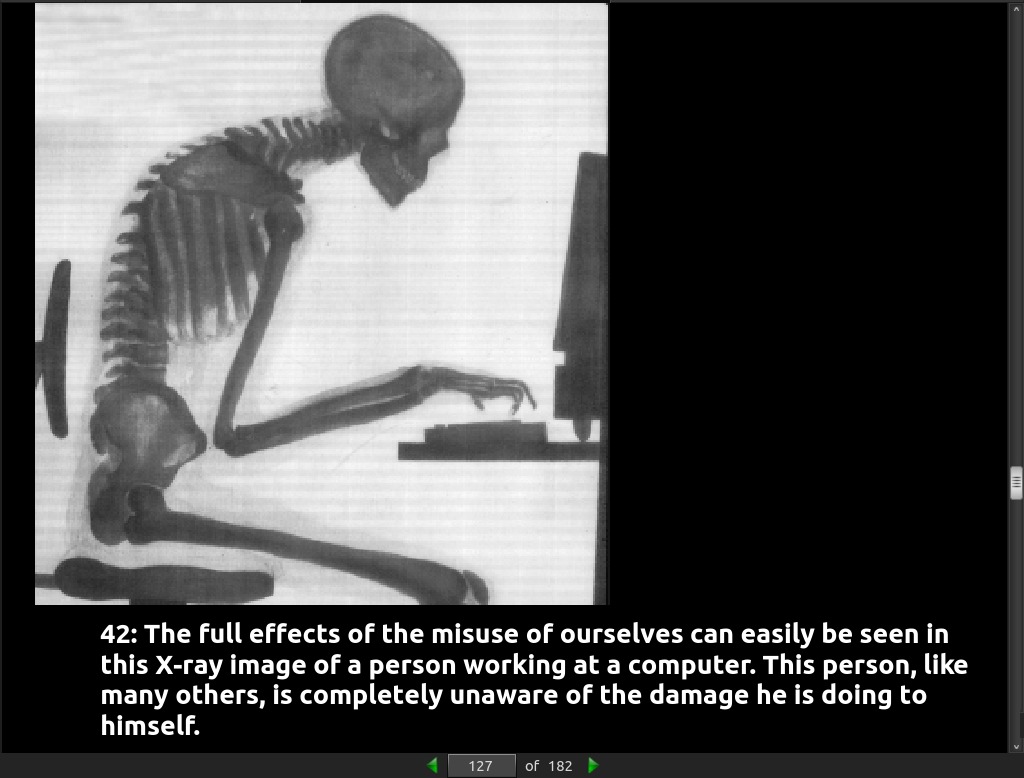
page 128:
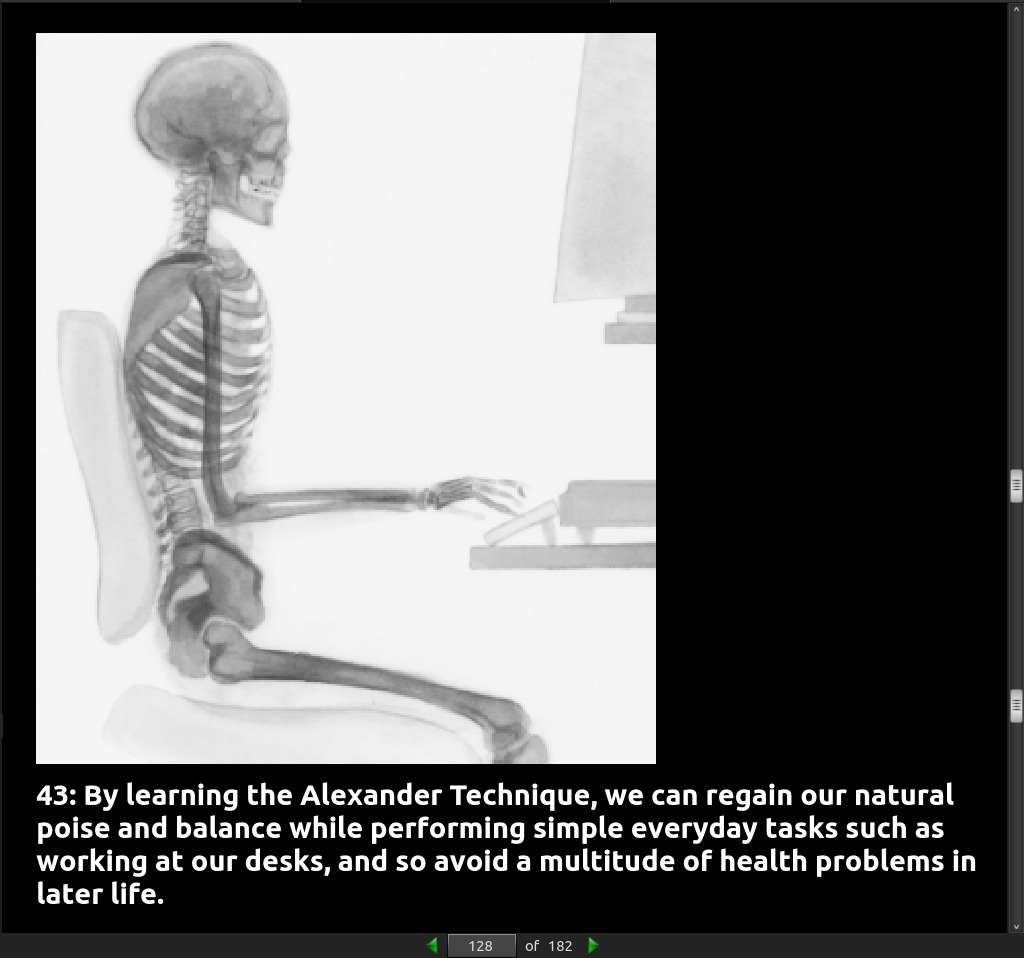
· 11: Inside Yourself
page 134:
- Many of us think of posture as only external, but it actually can affect the inside of the body just as much. Our internal organs can be squeezed by the over-tightening of the muscular system…
· 12: Posture and Shoes
page 140:
- The foot and ankle contain 26 bones, which means that over a quarter of the bones in the human body are in the feet. Each foot contains 33 joints and more than 100 muscles…
page 143:
- According to Dr Rossi, if a person wears a 5cm (2in) heel, their entire body is thrown forward out of alignment by 20 degrees. In order to stop ourselves from falling forward, a huge number of changes must be made to the organization of our precisely balanced framework. The pelvis rotates forward, taking away support of the internal organs within the pelvic bowl and abdomen. The lumbar vertebrae become more arched as the body fights to regain balance, and as a consequence muscles, tendons and ligaments all become strained. Most importantly of all, being off balance cause a backward and downwards retraction of the head, causing excessive tension in the head, neck and back area,
· 13: First Steps To Improving Posture
page 147:
- the emphasis on treating symptoms rather than root causes is just as strong today.
page 151:
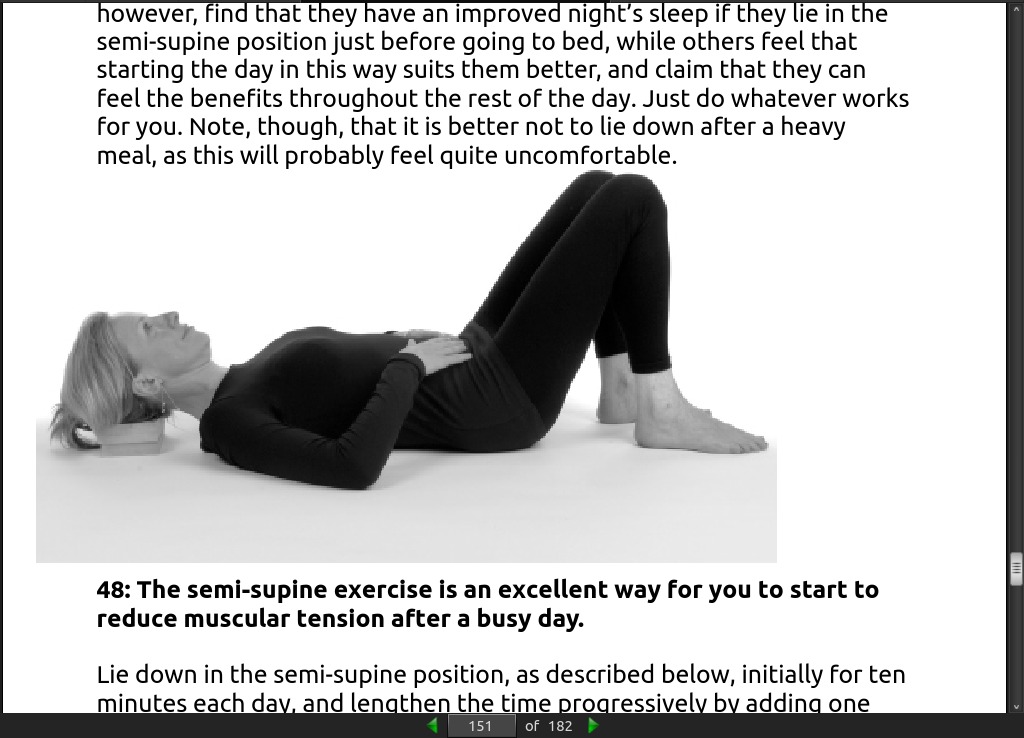
page 154:
-
Benefits of lying in the semi-supine position:
-
Improves overall posture.
-
Allows the intervertebral discs to absorb fluid and helps to increase height.
-
Helps to straighten the spine by helping to lessen the curves that have become exaggerated.
-
Lengthens the spine so that it can support you better when you are upright.
-
Releases muscular tension throughout your whole body.
-
Improves your breathing by helping to release the intercostal muscles and the diaphragm.
-
Improves circulation because the blood can flow better when the muscles are relaxed. Some of my pupils have found that their hands and feet have become warmer.
-
Puts less pressure on the nerves that have become trapped due to over-tense muscles.
-
Helps to prevent deterioration of the bones and joints of the spine and can even rejuvenate parts of the skeleton that have been worn from misuse of the body.
-
Allows the internal organs to have more room to function.
-
Helps to revitalize and re-energize you.
-
Brings about an overall reduction in stress and tension physically, mentally and emotionally.
· 14: Posture and Breathing
· 15: Bringing Your Life Back Into Balance
· Glossary
page 175:
-
Being present/attentive Being in the present moment and focusing your attention on the activity you are performing; not letting your mind wander into the past or future.
-
End-gaining Being too goal-oriented: thinking only of the end and not giving any consideration to the way in which you achieve the goal.